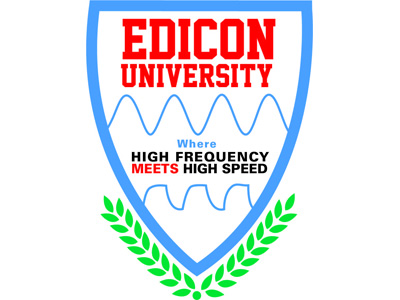EDI CON USA, the industry event that brings together RF/microwave and high speed digital design engineers and system integrators, is pleased to introduce its EDI CON University 2018 program at its event this October 17 and 18 at the Santa Clara Convention Center. These two-hour sessions offer in-depth training in a particular topic, such as MIMO test, amplifier design and measuring impedance.
All conference pass holders are eligible to attend, but pre-registration happens during the registration process. After attending an EDI CON University course, attendees can earn IEEE Continuing Education Unit/Personal Development Hour (CEU/PDH) certificates and enjoy a complimentary lunch on the expo floor. This year’s EDI CON University sessions are sponsored by Teledyne LeCroy, Mini-Circuits and Keysight Technologies. Here is this year’s line up:
Wednesday, Oct. 17, 9-11 AM, 3 courses to choose from:
Antenna Design for IoT, Henry Lau, Lexiwave Technology
This course offers participants technical insights on the vital aspects of antenna design from an industrial and practical perspective. It covers fundamental theory, concepts and definitions to the features, specifications and performance of different types of commonly-used and advanced antennas found in IoT products. Practical implementation strategies on overall product design for optimum antenna performance will also be presented.
Millimeter Wave Measurement Insights, Gennady Farber & Suren Singh, Keysight Technologies
Sponsored by Keysight Technologies, this university session covers both mmWave measurement challenges and specific techniques for component characterization. The first presentation covers the basics of making measurements at mmWave frequencies as it relates to transmission line theory, connector topology and over-the-air (OTA) transmission and will also examine a number of associated design and measurement challenges at these wider bandwidths. The second presentation focuses on how a vector network analyzer can be used to address the need for mmWave component characterization for both passive and active devices and will include real-life measurement examples.
How to Measure Ultra-Low Impedance (100 uOhm) and lower PDNs, Steve Sandler, Picotest
Today, it is common to see 500 uOhm power rails, but more recently the bleeding edge is below 100 uOhms. Measuring 100 uOhms is a significant challenge, even using the venerable 2-port shunt-thru measurement that has served as the staple of ultra-low impedance measurement. At these ultra-low impedance levels everything matters, from the quality of the instrument interconnects, to the quality of the ground loop isolator. In this tutorial, you will learn some techniques that will improve the accuracy and fidelity of your sub-100 uOhm measurements. You will learn the pros and cons of the 2-port vs 3-port measurement technique. With a little bit of luck, we will demonstrate a 100 uOhm impedance measurement as well as showing some measurements that highlight the challenges you will face along the way.
Thursday, Oct. 18, 9-11 AM; 3 courses to choose from:
Real Time Spectral Analysis of Power Rail Noise, Eric Bogatin, Teledyne LeCroy
Sponsored by Teledyne LeCroy, this session begins by noting that while the real world is the time domain, sometimes we can gain insight about the origin of problems by looking in the frequency domain. For some types of products, such as analog parts, mixed signal or clock generation, very low levels of power rail noise can have a big impact on performance. Sometimes the best way of finding these noise sources is by frequency domain analysis. In this seminar, we introduce the best measurement practices for analyzing the real-time spectra of signals and apply these methods to power rail noise to provide insight into the root cause of the problems.
High Speed Board Design Rules to Get Your PCB Designed Right the First Time, Shalom-Shlomi Zigdon, itech-icollege.com
Understanding the principles of signal/power integrity and EMI by the electronic engineer is necessary, but, unfortunately, our experience does not guarantee the successful functioning of the system. Converting the principles into quantities built by the PCB layout designer will bring us closer to this goal. This lecture will cover 10 critical issues regarding the return current path and bypass capacitors roles, crosstalk by coupling, gap crossing, layers construction and order, stitching vias and Faraday cages. All of these topics are converted into a guide that is concise but effective and proven to achieve the goals.
Build Your Own VNA, Aleksey Amitai, Vayyar Imaging & Aaron Vaisman, Mini-Circuits.
Sponsored by Mini-Circuits, this hands-on course is designed for university students, graduate students, engineers who are early in their career or anyone who wants a better understanding of how measurements actually work and what effect a good measurement has on your design. The goal of this course is to bridge the gap between academics and real-world engineering. Attendees will work in teams to build a VNA, load the scripts, talk about the math behind the measurements, make a measurement and see if they got the measurement correct. Topics covered include: transmission line theory and lab measurements, basics of S-parameter measurements, and construction of a VNA.
In addition to two full days of conference programming, including the above courses, plenary keynote talks, technical papers, workshops and panels, EDI CON USA 2018 includes a celebration of innovation in the EDI CON EXPO hall, complete with show-floor networking opportunities and speed trainings.
More information and registration is available online. EDI CON USA 2018 is supported by its primary media sponsors, Microwave Journal and Signal Integrity Journal. More information, including how to exhibit at EDI CON USA 2018, is available at www.ediconusa.com.

